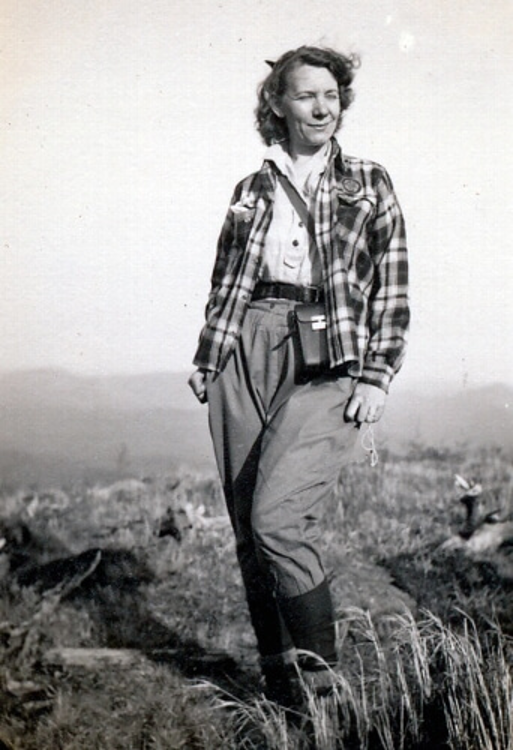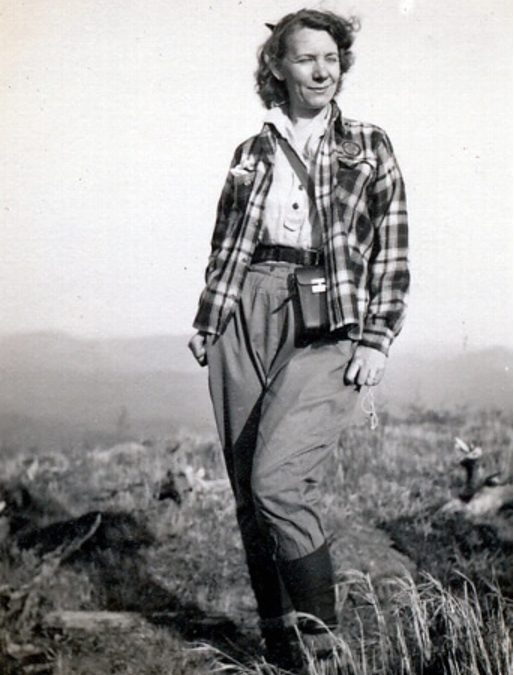
In celebration of Women’s History Month, this episode tells the story of Grace Leach Hudowalski, the first woman to summit all 46 of the Adirondack High Peaks. Besides being an accomplished mountain climber, Grace was also the first president of the Adirondack 46ers Club as well as its historian for over 50 years. As historian, Grace answered thousands of letters from club members telling her of their exploits as they reached each of the 46 summits. An accomplished writer, Grace promoted the Adirondacks through her work as a tourism writer for New York State and through her many articles for the Adirondack Mountain Club Magazine.

Marker of Focus: Grace Leach, Essex County
Guests:
Laurie Rankin, President of the Adirondack 46ers club, and Jane Meader Nye and Tony Solomon, Adirondack 46ers club members and friends of Grace.
A New York Minute in History is a production of WAMC Northeast Public Radio and the New York State Museum, with support from the William G. Pomeroy Foundation. This episode was produced by Elizabeth Urbanczyk. Our theme is “Begrudge” by Darby.
Further Reading:
The Adirondack High Peaks and the Forty-Sixers(1970), edited by Grace Leach Hudowalski.
The Mountains Will Wait for You, (2013), a film about Grace Leach Hudowalski by Fredrick T. Schwoebel and narrated by Johnny Cash.
Hiking the Adirondack 46 High Peaks: A Guide to the Region’s High Peaks(2024), by Johnathan Zaharek.
The Adirondacks: A History of America’s First Wilderness (1998), by Paul Schneider.
Teaching Resources:
The Adirondack Experience: The Museum on Blue Mountain Lake Educational Resources
The Adirondack Mountain Club School Outreach
The records of the Adirondack 46ers club, 1940-2013, New York State Library
The Wild Center School Programs
Follow Along
Devin: Welcome to A New York Minute in History. I’m Devin Lander, the New York State historian.
Lauren: And I’m Lauren Roberts, the historian for Saratoga County. In honor of Women’s History Month, we’re looking at a marker located in the town of Ticonderoga in Essex County. The marker is located at 10 Montcalm Street, and the text reads: Grace Leach, born near this site in 1906. She became the first woman to climb the Adirondack 46 high peaks, completing her climbs in 1937. William G. Pomeroy Foundation, 2016.
Grace Leach is also better known by her married name, Grace Hudowalski And she is a fascinating woman. Although, as a young girl Grace grew up in Ticonderoga, her parents thought it was important that she moved to Troy so that she could attend a high school. So in the early 1920s, her family moved to Troy where she attended school, however, her father operated a hotel in Minerva, so she was never too far removed from the North Country.
In the summer of 1922, when Grace was a teenager, she joined a group of young people who were going to hike Mount Marcy, and this is her first experience climbing one of the high peaks, which we should probably say is the 46ers are considered any of the high peaks in the Adirondacks over 4000 feet. And there’s a little leeway with that, too. But that is – the general idea is – that all of the high peaks over 4000 feet that they knew about at the time, are included. So Grace joins this group and she climbs Marcy, and it’s a hard climb, it’s not a nice day out. She mentions that, you know, a lot of the time she’s on all fours, and it’s really difficult. And some of them turn back but she doesn’t and from the top clouds part and she looks down and she can see Lake Tear of the Clouds, which is the source of the Hudson River.
Devin: The 46ers – as an active organization – began in February of 1937, when they were called the 46ers of Troy, because that’s where Grace and her husband, Edward were living and others who were very interested. But the organization itself traces its roots as far back as 1918, when Robert and George Marshall – who were New York City gentlemen who were interested in the Adirondacks, because they spent their summers there – climbed their first high peak, which was Whiteface Mountain. In 1922, Robert Marshall publishes kind of the first book about the high peaks that describes them and, and as you noted, there is some leeway. Some of them are not quite 4000 feet, but most of them are right up to Mount Marcy, which is the highest elevation in New York State at 5344 feet. So the 46ers kind of started as an unofficial group of people who are very interested in climbing the high peaks in the Adirondacks and climbing them all. In 1837. They formed the official club of which Grace was the first president And to learn more about that we spoke with current Adirondack 46 or President Laurie Rankin.
Laurie Rankin: So I am Laurie Rankin, I am the president – current president – of the Adirondack 46ers, I am member number 5525 with the WV after my name and number. The W stands for having climbed all of the peaks in winter, as well as in the three seasons. And the V stands for having given at least 146 hours of volunteer service to the organization.
So the organization is – in our mission statement – dedicated to people who have climbed off 46 high peaks, but also who are very involved in education in preservation of the environment. And we also are working with the New York State Department of Environmental Conservation on some of their environmental goals. Mostly those have to do with stewarding and with trail crew work. And then finally, we also are very involved in supporting other organizations that hold similar missions in the Adirondack Park. So we actually go back to an earlier organization to talk about Grace and how she came to be the very first president of the Adirondack 46ers back in 1948. So Grace, as a young girl, attended a church in Troy, as did some other folks. And they’d heard about these people, [the] Marshalls and Clark, who had climbed the mountains in the Adirondacks. And they thought, “Wouldn’t this be a great thing for the kids to do here and Sunday school?” And so they started climbing and taking some of the kids with them. And this young Grace had heard about this. And she thought, “Well, wow, that’s something I would like to do.” But of course, at the time, this was not something that girls or women did very often. And with the support of her father, in particular, Grace decided to give it a try. And so as a girl, she climbed one of those mountains. And she wasn’t sure if she could do it a few times, she was worried about keeping up with the lads. But she did it. And she found great joy in doing that. Eventually, she continued to climb the involvement in that church, which was actually the Grace Methodist Church in Troy, was the original start of an organized group of people who were dedicated to climbing those peaks. And so it was a fairly small group of people at the time. That is kind of where Grace got started. The organization itself, of course, started actually in 1948. And by then she and her husband were married. And she was the first woman to have climbed all the peaks, only the ninth person to do it. And the very first woman.
Lauren: It’s important to remember that at the time that Grace and Ed were hiking and starting this club, it’s not the 46 that we know today, there weren’t paths that were guided by trail markers. You didn’t have trail crews and stewards that were in there making sure that you didn’t have a mile worth of mud or you know, they were moving The Boulders out of the way or or downed trees in a storm. We have a much easier climb nowadays, then, Grace and her cohorts did back in the 20s and 30s. And Grace actually finished her 46 In the year 1937. She finished on Esther, when she was just over 30 years old.
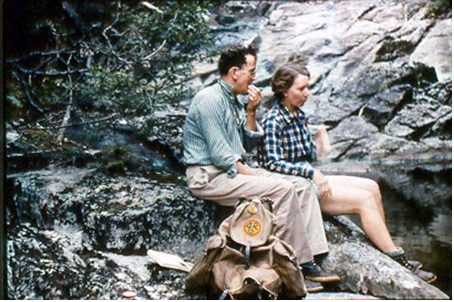
Devin: I think that’s a great point that you make about how the high peaks are different today. One of the things that the Adirondack 46ers and their predecessor, the 46ers of Troy really did as a club – it wasn’t just about climbing the mountains and getting your number and your name in the record book. It was about things like preserving the mountains in their pristine shape, they did work on trails and also did work to not create trails, because sometimes when trails are created on these kind of high peaks, they can cause environmental damage due to runoff and things like that. So they actually worked on guiding people to the tops of these mountains without specific trails so that they would not be trails kind of dug into the surroundings. But they’ve done all sorts of work many publications and really Grace. Even beyond her presidency, as the first club president became the institutional historian for over 50 years.
Laurie Rankin: Grace was a very organized individual to begin with. So when it started, she was like, “Well, now how are we going to put this group of people together?” And to hear her tell the story of even trying to determine how to organize, so that we know who climbed first and who climbed second, and things like that was something that she was very thoughtful about. And so she actually went by the dates by which people completed climbing the 46 peaks. As she continued through her journey, she just simply enjoyed listening to what other people were doing in their climbing journey. She loves to support, she loves to hear the stories, she has said, there are several famous quotes that she said, one which came from her dad, and was simply “It wasn’t about getting to the top, but it was how you enjoyed the climb along the way.” And she wanted to hear about that, she truly did. And she felt that it was a gathering of people, this club, this organization that had this commonality of how they made that climb. And she wanted that information as part of the record. So that it wasn’t just simply giving somebody a number, and saying “Congratulations!” – That there was more to it. And of course, in the early years, that was something that she was able to keep up with very, very well. But as the organization began to grow, it became really, really a full time job, if you will. But again, she was very dedicated to it. And she loved to truly love to hear what people had experienced when they were out there climbing. And not always the good things, sometimes the things that didn’t go so well as well. So her boots, we don’t say her shoes, but we say her boots or hiking boots, eventually had to be filled by several people. And because Grace corresponded with all these people, we call those folks the Correspondents. And letter writing has sort of gone a little bit out of vogue. And we correspond most often electronically now. But it still retains the same important information that Grace wanted to hear, and wanted to share with others. And that is about that experience, not just to say, “I got to the top of Mount Marcy on Tuesday, such and such a date.” And, “Here’s your finish number.” It was all the special stuff in between that connected them, and still does.
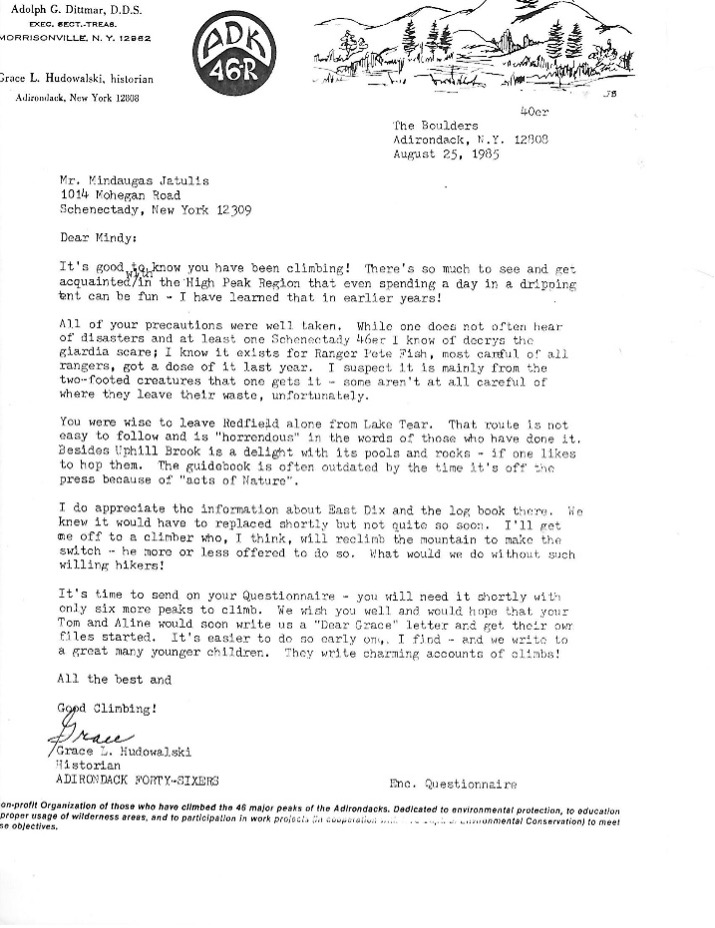
Lauren: I think it’s such a great way that she was able to take hiking, and bring it away from just the physicality, the athleticism, how fast can you get to the top, right, that’s not the point of becoming a 46er. Because there are a lot of, you know, strong, able people who can run up; And I think they use the term sometimes, you see the term “bagging a peak,” right? Because they’re trying to get to the 46. But for Grace, it was so much more than just the strength that it took to climb the mountain, the physical strength, it’s the relationships formed along the way. It’s the memories that are made. And that includes the failures and the triumphs. There’s lots of times that Mother Nature throws curveballs in the way of hikers where you think you’re going to be able to get to the top of this mountain today. And that doesn’t happen. And I think Grace had that knowledge from an early age because of the way she talks about what her dad said to her as a young girl. But the idea that it’s about the memories that you make along the way. It’s these relationships formed between hikers. And Grace’s way of capturing all of that, and making the hikers actually reflect is by writing these letters. I mean, I think it was mentioned that by the time she finished, she had written over 60,000 letters. I mean, that that’s an amazing accomplishment. And we’re not talking about email here. You know how many emails you can fire off in a day. She’s actually going to the post office, collecting these letters, reading them all and thoughtfully writing back to these people. And there’s this wonderful archive that’s been created about all of these 1000s of people and there’s 1000s of members of this club now. And they have a written legacy about what it’s like to climb these peaks. And I think reflecting on that also is one of the reasons that they’re so interested in preserving them.
When Grace first started writing back to climbers, there were a good number of them. But the club grew very quickly. And it became a bit overwhelming to Grace in her later years; she was getting older, the letters were just coming in faster and larger quantities. So she started to have some helpers. And I’m lucky enough in my office as the Saratoga County Historian, that one of my volunteers Jane Meader Nye, who is 94 years old, and has been volunteering in my office since the 1990s. She was a friend of Grace. And her husband, Tony Solomon was also a friend. And they were helpers. They met Grace because they have their love of hiking. And I sat down and spoke with them to learn some of their favorite memories about Grace Hudowalski.
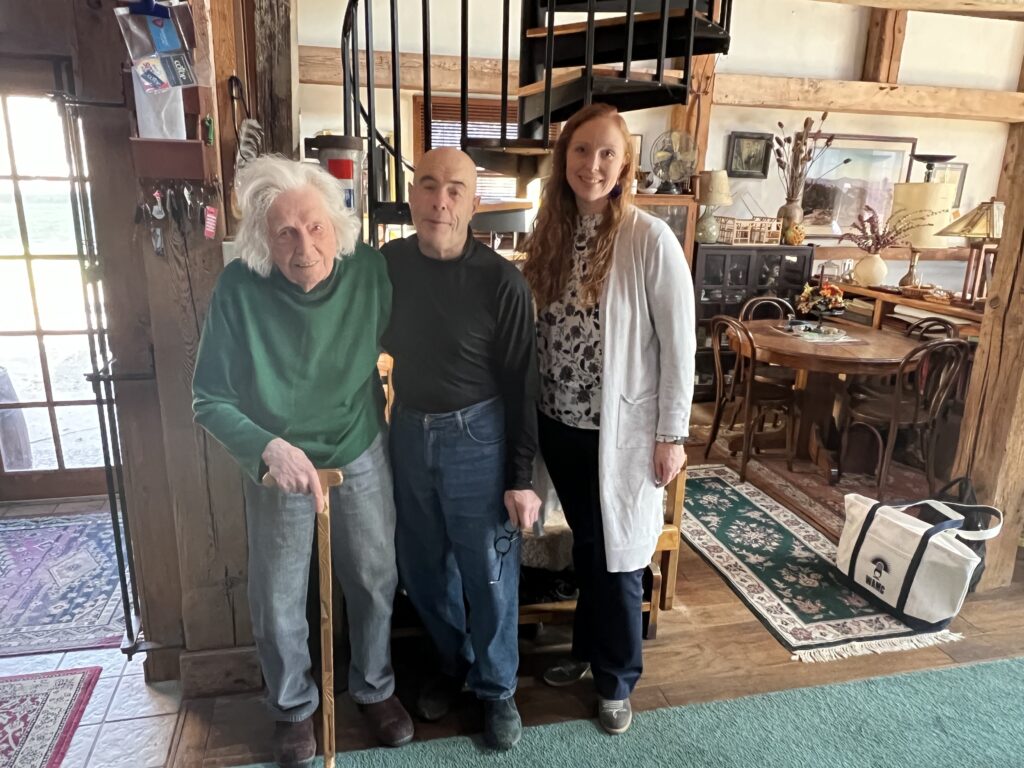
Jane Meade Nye: My name is Jane Meader Nye, I’m local, I grew up in Schenectady, New York, I was born in Ellis Hospital, so I never got far from home. But I’ve wandered all over the world.
Tony Solomon: My name’s Tony Solomon. And when I retired, I was also at the time a 46er. And being bored, I contacted the president of a club, and I said, “If you need any volunteers, I’d like to help.” And she said, “That’s good! Grace lives at nine Cardinal Avenue. And what we want you to do is you go in the back door, the back door is open, there’ll be somebody there by the name of Mindy, and Mindy will introduce you to Grace.”
The reason why she needed help, she was inundated with work, answering letters, and so we would help her with the letters. Grace felt that if you climb a mountain, it’s good enough to write about it, tell us about it. And if you wanted to be a 46er, or you wrote to Grace, you said: “Dear Grace, I’m starting to climb 46 peaks.” And she would send you a mountain list where you’d write your mountains down. And she didn’t require this, but she would appreciate a letter every time he climbed a mountain or time to climb two or three mountains to tell her about it. She also would like – if it’s a child – and have the child write their own letter, she loved having letters from children, we’d help her go over the letters. And she’d write the replies pretty much. But we sometimes would like some. When we started helping Grace, there were about 200 new 46ers every year, and these people would be writing in and she put all the letters and organize them and they’d be in order of finish, because every 46er gets a climbing number, based on when they finished. So we would do that. And then she also required that everything would be put in a loose leaf notebook and you had to make two copies of it. One copy stayed with the 46ers. The other copy was – at the end of the year – went to the State Library.
And then Grace lived at Cardinal Ave for about six months of the year and then she moved to her cottage – actually was nice cottage – up in Schroon Lake, called The Boulders so when she moved up there, Jane and I, we went to the Boulders to help her. And on the way up to the Boulders we would stop at the post office in Adirondack, New York to pick up her mail and then go to The Boulders and she would make us lunch – usually it was toasted cheese.
Jane: Grilled Cheese.
Tony: We’d spend the day there. And we developed a really good relationship.
Lauren: One of the interesting stories that came out of my conversation with Jane and Tony was about Grace’s connection to Noah John Rondeau, who was known as the Hermit of Cold River. Grace met him when she and her husband went in to climb the Sewards – and where he was in the woods was not an easy place to get to. It was a 14-mile walk and she and her husband went in he offered to help them find their way across the swamp to the mountain that they were climbing at the time, and on their way back offered to make them a cup of coffee and Grace talks about this experience as part of the documentary called The Mountains Will Wait for You that talks about Grace’s legacy with the Adirondack 46ers, she also mentions that after that every year on his birthday, she would bring a birthday cake in.
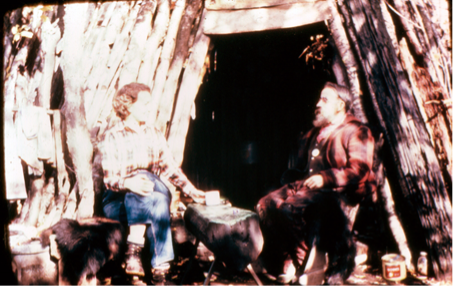
Tony: There was a hermit that lived up in the cold river and his name was Noah John Rondeau. And he made a home there.
Jane: Very primitive.
Tony: Very, very primitive camp. I mean, this is a very difficult place to get to. I mean, it was a long, long hike from any place. And Grace – and some of the other 46ers – have gone there once. She had gone back again, several times. And she would carry a birthday cake.
Jane: Every year, every year.
Tony: They had a hurricane in 1950. A terrible, terrible hurricane. And it did a lot of damage up in the Adirondacks. And the Conservation Department wanted Noah out of there for years. But he wouldn’t go and they didn’t have, I guess…
Jane: …the ability to make him.
Tony: Yes. And pretty soon after the hurricane. They got him out. And he never went back. People knew about him. I don’t know how but they did. I mean, I remember as a kid I knew about him. Evidently, she went in there by herself.
Jane: From what I’ve put together, she went by herself.
Tony: It would be three days for us. I mean, two nights and three days. It’s a long hike. I mean, she… I can’t believe she did it in a day.
Lauren: With a birthday cake in her hand.
Tony: I can’t believe she did it. I mean, but… She did.
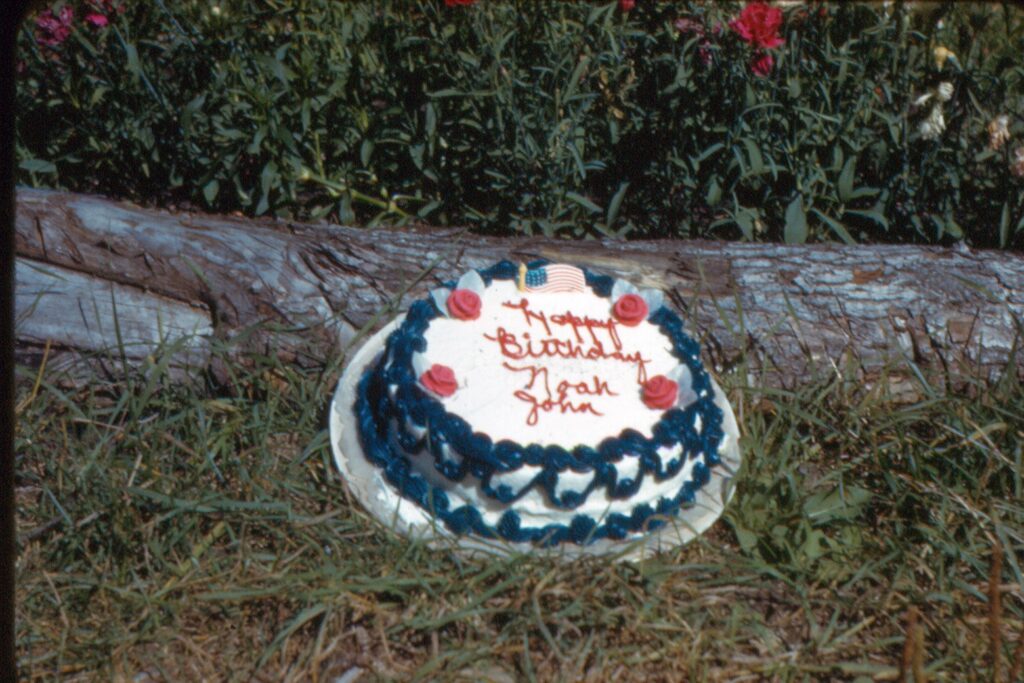
Lauren: Another great event in Grace’s life was the 60th anniversary of finishing her 46th, which happened on August 26 1937, on top of Esther. And for the 60th anniversary of that Grace was brought to Whiteface. And still at that time, even in her older years, she was determined to climb to the top by herself.
Tony: Somebody was always coming up with ideas, and they still come up with ideas. And so we put a 46er on each one of the summits. And I climbed Whiteface -that was the one that I climbed. And then Jane drove Grace up Whiteface. And the first surprise was that Grace worked for the State. And she had a really good job with publicity and, and they gave her, when she retired, this silver medallion that enabled her entrance into any state building or park or wherever. So instead of paying, she just showed the medallion, and they drove up. And I met them at the parking area, and the idea was to take the elevator up to the top. And Jane is walking up with Grace and Grace takes one look at [the elevator]. She says “I have never ridden in that elevator and I’m not gonna ride it now.”
And you know, she was like 90 years and over 90 years old at the time.
Jane: About 93, maybe.
And there’s a stairway that goes up there, and it’s rather steep, and it’s a quarter of a mile. And she walks up that stairway – she and Jane are going up the stairway – and I’m following behind.
Jane: I had her pack, a small pack on my back.
Tony: A lot of people up there that day – it was probably a weekend or something – and we get up to the top and she sits on this big boulder. And the next thing we know somebody had contacted Channel 5 from Plattsburgh and they’re interviewing her, but that – oh! And then – I’d forgotten – and afterwards we went back to her camp at The Boulders at Schroon Lake and then everybody that had climbed a mountain came back there and we had a rather nice celebration
Jane: That we did.
Tony: Yeah, that was good. It was a lot of… a lot of fun.
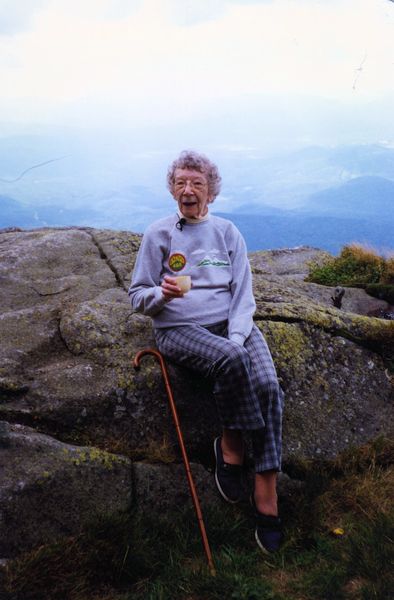
The Adirondack 46ers.
Lauren: Grace passed away in 2004 when she was 98 years old, but her legacy lives on. Her presence is felt so much so that some of her fellow hikers and 46ers went through a grueling, decade-long process to get one of the high peaks renamed after her. And after about 12 years, the peak East Dix was finally renamed Grace Peak.
Laurie: That was a very, very long process. And I will say that the credit to that goes to Mr. Doug Arnold, who was just fearless and going out there and meeting the very stringent criteria of the USGS in order to rename a mountain. And there was tons of legalese, if you will, that had to be followed. But aside from that, there was also – he had to prove that there really was a support locally for the renaming of this and then at the same time, he had to prove to people what an important person Grace was, and why she deserved to have her name on this peak, so it was extremely involved. It was very lengthy. And you had to maintain that momentum and that support during that time frame. And so my involvement was, was really just minute, behind the scenes, here or there and trying to get people to attend public meetings, those kinds of things. Doug really is the one who gets all of the credit for that.
Lauren: It shows how dedicated Grace was and how much of her time was spent, because she had a spiritual connection with the mountains. And that’s something that she wanted to foster with others. And she encouraged not only women to write letters, but the men had to write their own letters. And she talks about how sometimes, you know, men didn’t want to write letters, but she made them write. You know, she didn’t want the wife to write for both of them. She wanted to hear individual experiences. And even when young children were hiking, they were drawing pictures, even if they couldn’t write, they would dictate to their parents, but sometimes included pictures. It really seems like, you know, she was able to take the joy that she felt on the mountains and spread it to others, and that the joy she received from reading these letters, and, you know, living others’ experience in the mountains was really what what kept her going and living till 98 and continuing to do this work, and then passing it on to others like Jane and Tony and other Correspondents now. And even though they use email, the sentiment is the same; people are still documenting their experiences in the high peaks and sending it in to become a part of this kind of unique club.
Tony: She was the organization I mean, she was with it right from the beginning. She was the one that you wrote to when you wanted to start to climb, she was the one that presented your certificate to you, when you came to the 46er banquet in May to get your climbing number. It’s… Grace was the organization; she made the rules.
Laurie: I think that one of the other things that I liked about Grace, and I really like about the 46er organization is we have tried very hard to keep the traditions and the history alive. We really like our new climbers to know who Grace was, we really want them to know what she gave to the organization. And a quote that I do remember of hers was that “We don’t use titles in the mountains,” she would say. We are all climbers, and we are all out there joyfully. And we don’t give titles to one another. And we’ve tried to remain pretty humble, I think, and followed in her footsteps that way as well.
When we were celebrating Grace’s birthday, several years ago, we were hiking each of us to different mountains of the 46. And Grace’s favorite bird was the hummingbird. And I – and my husband – hiked to the summit of Mount Colden. And it was a very cold, rainy day, and there’s not a lot of blooming plants at the top of a mountain. And yet, we were greeted by a hummingbird at the summit of that mountain. And this was after Grace had passed and, and I kind of thought to myself, “Wow, she’s here.” And so I hope in the short time that I’ve been able to help the organization that I have kept Grace’s words in the back of my mind. And that visit that she made to me on Colden.
